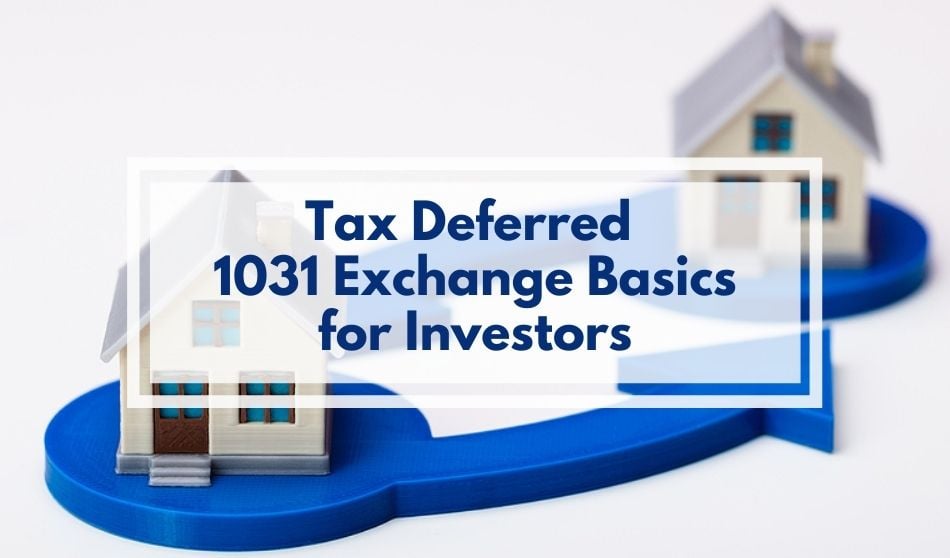
Finding capital for investment opportunities can be daunting for investors these days. Freeing up capital by selling a property is one method of financing portfolio growth. But the downside is an immediate tax burden.
A 1031 exchange strategy allows savvy investors to grow their portfolio without any impact on cash-flow while deferring paying taxes on capital gains. This handy option allows an investor to release under-performing properties to grab growth potential opportunities.
1031 Exchange Basics
- Swapped properties must be used for business or investment purposes such as a rental or business.
- To qualify for a tax deferral on capital gains, the property purchased must be equal or greater than the one sold.
- A qualified professional intermediary must process the paperwork and finances for both the sale and purchase of properties.
- There are specific criteria, rules, timing, and regulations that must be followed to qualify.
- There is no limit to how many times or how many properties you can exchange.
What is a 1031 Exchange
As the term implies, you are exchanging one property for another of equal or greater value. These transactions are facilitated by a third-party intermediary. Following the IRS 1031 tax rule allows the tax burden from the sale of the initial property to be deferred.
The IRS tax code (IRC) section 1031 provides the framework for the exception. It allows postponing paying tax on that gain if those funds are used in the property time period for the appropriate type of property as part of a like-kind exchange transaction.
1031 Terms to Know
Familiarizing yourself with 1031 exchange terms can help demystify the process. Here are some common terms to get you started:
Relinquished property
The relinquished property is the property to be sold and the proceeds of that sale will be exchanged for equity in the replacement property.
Replacement property
The property to be acquired by the sale of the relinquished property through a 1031 exchange qualified intermediary.
Qualified intermediary
The party who participates in facilitating the exchange for a fee but is in no other way related to the transaction and has no other monetary interest. This intermediary is also called a facilitator can not be an investment nor a real estate broker, accountant, attorney, nor employee. Qualified intermediaries are typically engaged in these exchanges as their primary occupation.
Capital gains
The profit resulting from the difference between the selling price and its adjusted cost basis is immediately taxable unless all the conditions are met to qualify for a 1031 tax deferral.
Note that the capital gain or loss isn’t determined by the purchase and selling price alone. It factors in such items as the cost of capital and assessment improvements. It also includes depreciation and other losses that have been taken. The resulting balance is what’s called the Adjusted Cost Basis.
Speak with your accountant for specifics on what is included in an adjusted cost basis and how capital gains are calculated.
Properties That Qualify for a 1031 Exchange
The properties in an exchange can not be a primary residence and must be used or held for business or investment purposes. Those would include a non-primary residence such as a former residence, rental property, second home, vacation home, and commercial property.
There are a few exceptions. Your current residence might qualify for a 1031 exchange if a portion of that home had a home office or a portion was rented out. For example, renting out a room or additional dwelling unit (ADU) on the property might qualify. In some instances, you may qualify for an exchange if you are moving due to a divorce.
To see if the property qualifies, speak with a professional qualified intermediary to confirm qualifications before engaging in a 1031 exchange.
Common Types of 1031 Exchanges
A simultaneous exchange is the simplest exchange possible where one property is swapped for another simultaneously.
Although more complex than a simultaneous swap, the most common 1031 exchange is a delayed exchange outlined below.
Other exchange types include an improvement exchange, personal property exchange, a reverse exchange (where the replacement property is located first before the sale of the relinquished property), and a Delaware Statutory Trust Exchange, also known as a DST 1031.
Delayed 1031 Exchange Process
As the delayed 1031 exchange is the most common, let’s review the steps and rules required:
- Contract with a qualified intermediary. They will properly document the properties (current and new) in the exchange and are responsible to hold the proceeds from the sale of the first property until the close of escrow on the replacement property.
- List the relinquished property for sale.
– You have 45 days of the relinquishing property sale to identify the replacement property.
– You do not need to wait for the sale to start looking for the replacement property. - Identify the replacement property. You can either:
– Identify up to (3) three properties and close on one of them within 180 days or,
– Identify an unlimited number of properties totaling less than 200% of the sale price of the relinquished property and close on one of them within 180 days. - At the close of the replacement property, the qualified intermediary will transfer the proceeds of the relinquished property towards the purchase of the replacement property.
These are the general steps and rules. There may be additional identifying options, property types, and caveats so it is advised to consult with your qualified intermediary.
1031 Exchange Timelines
It is important to note that the 45-day rule and 180-day rule run concurrently. The clock begins on the day the relinquished property sells for both rules and both deadlines must be met to qualify.
That means, as soon as the relinquished property sells you have 180 days to close on a new property (and must identify which property you are purchasing within the first 45 days).
For example: if it takes you only 30 days to find a replacement, you have 150 days left to close on that property.
Remember, the replacement purchase must be of equal or greater value than the relinquished property.
As with any 1031 exchange, to take advantage of the tax deferral, be sure to hire a qualified intermediary familiar with the process.
The Risks & Rewards of a 1031 Exchange
Rewards
In addition to deferring the tax burden of capital gains, a 1031 exchange allows an investor to pursue the purchase of better investment properties. In turn, could generate better returns without the need to find new financing.
For example, it might make sense for an investor to exchange a duplex for a quad-plex or a small apartment unit for a larger one to acquire more doors in their portfolio.
Risks
The real estate market as a whole has inherent risks in market value changes and asset availability. Because a real estate transaction might not go according to plan there runs a risk that you might not be able to complete each transaction in the window of opportunity to take advantage of the 1031 exchange.
For example, if you are unable to identify a replacement property within 45 days and close on that property within 180 of the relinquished property, the 1031 exchange would be void, and taxes on that original sale will be due.
With any investment consideration, it’s vitally important to consult with your financial advisor or accountant. Be sure to discuss opportunities, options, risks, and corresponding tax implications.
Wrap-up
With the current market and world events, we all need a break these days. It’s always a good idea to research investment options and tax breaks when possible. A 1031 exchange might not be for every investor, but when done correctly, can help grow a portfolio by selling a property to finance that growth; all the while deferring the tax burden.





